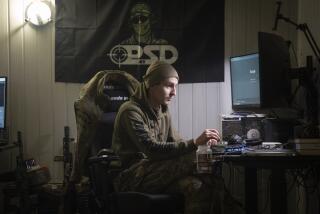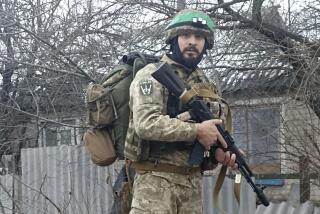U.S. Patrols Smuggling Routes to Macedonia
- Share via
MACEDONIA-KOSOVO BORDER — At dusk, leaf and branch fade to gray high in the rugged mountains on the border between Macedonia and Kosovo.
The only sounds are distant cowbells, evening bird songs and, when night falls, gunfire--the audible sign of the nearby conflict between ethnic Albanian rebels and the Macedonian military.
One front line is even closer.
Invisible in the bushes, three U.S. soldiers in camouflage crouch, their weapons cocked; a hundred feet away, three more soldiers take the same position.
The six surround a narrow clearing that looks like any other opening in the Kosovo woods.
It is anything but. The trail, one of many, leads straight over the border south into Macedonia. For months, it has been a key arms smuggling route for ethnic Albanian rebels, who call themselves the National Liberation Army.
“They are moving vehicles, mules, horses, laden with arms,” says Capt. Daxs Stadjuhar, a native of Lubbock, Texas, who commands a company of about 140 soldiers based in the Kosovo town of Vitina. They alternate weapons interception with standard peacekeeping activities in Kosovo, the separatist province of Serbia, Yugoslavia’s main republic.
In the two months since the NATO-led troops known as KFOR made interdiction an integral part of their mission, they have hauled in a startling number of arms: more than 600 rifles, including 45 machine guns; 48,829 small-arms rounds; more than 1,000 antitank weapons; 2,438 antitank rounds; 658 mortar rounds; nearly 1,400 grenades and mines; and piles of support equipment such as uniforms, boots, medical supplies and flak jackets, according to a mid-August report.
KFOR soldiers have detained 484 people--and nabbed a couple of dozen horses and mules. In the Balkans, weapons smuggling still relies on old-fashioned animal couriers able to negotiate rocky mountain trails that would defeat even the most rugged jeep.
Arms interception is the latest mission of the Kosovo peacekeepers, who arrived two years ago after an 11-week NATO bombing campaign against the regime of former Yugoslav President Slobodan Milosevic. More difficult and dangerous than any job they have undertaken, it is increasingly important as well.
The ethnic Albanian rebels who have taken up arms to fight for more rights for Macedonia’s ethnic Albanian minority have been getting some of their supplies from Kosovo, where ethnic Albanians are in the majority. As the North Atlantic Treaty Organization tries to broker a peace in Macedonia between the ethnic Albanian rebels and the Macedonian government, its soldiers must demonstrate that they aren’t supporting either side. For one thing, that means making every effort to shut off the rebels’ arms supply.
But if the interdictions are any measure, the rebels are already extremely well armed and well organized. Despite KFOR’s recent successes, the guerrillas have stockpiled a number of weapons.
Arms Seizures Hint at Difficulties to Come
The sheer number of arms seized suggests the difficulty that NATO will face when it tries to disarm NLA fighters, as it has agreed to do in a deal with the Macedonian government and the rebels.
The interdictions may represent no more than 15% of the arms and supplies being smuggled across the border, said one Western official who has been monitoring guerrilla activities. Arms are almost certainly also coming from Albania, where there are no NATO troops to capture them, the official added.
The NATO mission in Macedonia, which is slated to begin as soon as there is an enduring cease-fire, is a short-term effort designed to last only 60 days and aimed solely at disarming the ethnic Albanian rebels by collecting and destroying weapons that the guerrillas voluntarily bring in. For Stadjuhar, a 6-foot-6 soldier who mixes friendliness with a commanding presence, the interdiction mission has been a lesson in the subtleties of guerrilla armies. This sector of Kosovo is patrolled by U.S. troops, who have focused increasing amounts of energy on interdiction.
“We’re the cops from out of town,” Stadjuhar says. “We don’t know all the hide sites and the places where you can’t be seen.”
Despite all of the U.S. forces’ technological advantages, the guerrillas have two huge assets: the utter loyalty and commitment of the ethnic Albanian villagers who live on both sides of the Kosovo-Macedonia border and a deep knowledge of the rough mountain terrain.
Distinguishing Between Rural and Rebel Signs
The Albanian villagers in Kosovo fully support the NLA fight in Macedonia. Amid white plaster farmhouses with terra-cotta roofs and bucolic herds of sheep wandering the hillsides, the villagers have supplied NLA rebels with safe houses, food and vehicles. A recent search by U.S. troops of a farmhouse on a riven dirt road high in the mountains revealed 30 futons that military sources believe furnished sleeping quarters for NLA soldiers.
Often, U.S. soldiers observe large numbers of men of fighting age accompanying older men into the woods to cut down trees. Later they see only a few of the men return to the village. None of the soldiers knows for sure if the other men have walked over the border to join the rebels to the south or are just cutting wood in another valley.
High on the border, signs of the rebels are scattered over the hillsides. On a ridge, Sgt. John Trevino, a former Marine from Ft. Campbell, Ky., who now serves in the Army, points out a tree with a number of Albanian names carved into its trunk. “Probably a signpost,” he says.
There may have been a weapons cache nearby, and the instructions to a new recruit might have been to go to the tree with the names carved into it, turn right, pick up an AK-47 assault rifle hidden under some leaves, and keep to the path that winds south over the border, Stadjuhar says.
Other signs of the rebels are large piles of charred wood, suggesting that perhaps earlier in the year, when it was colder, people built campfires when they stopped for the night.
But it’s tricky for the U.S. soldiers to figure out when they’re observing covert shipments to the guerrillas in Macedonia and when they’re just noticing signs of rural life in this simple mountain culture. Recently, Stadjuhar’s men noticed flashes at night in a field high on the border. The flashes came every night at about the same hour. They hypothesized that it might be men passing guns on to fighters traveling through the passes.
Instead, they surprised three farmers who were carrying flashlights. It turned out the farmers came to their fields each night to scare off wild pigs that were ravaging their fragile corn crop.
Still, the soldiers have to decide every day whether to search trucks of hay and wagons with sacks of grain--or is it bullets?
“Up here, they are UCK fanatics,” Stadjuhar says, pointing to the village of Buzovik, using the Albanian initials for both the NLA and the former Kosovo Liberation Army, which disbanded after NATO troops entered Kosovo. When U.S. troops searched one of the houses, they found UCK memorabilia, arm patches and posters.
Land Mines Limit Reconnaissance Work
Several times a day, the U.S. soldiers do reconnaissance, following trails that wind over the mountains to Macedonia. They check for signs that someone has been there recently. They look for footprints, mule and horse tracks and motor oil.
For every trail they go down, they pass up another. Sometimes it’s because the trail leads toward known minefields; sometimes it’s because it looks unused, suggesting it might be mined.
Sgt. Jeremy Johnston, 28, a native of Syracuse, N.Y., who was spending the night on watch duty early last week, summed it up. “There are so many trails, God knows which ones they are using,” he says. “There’re not enough of us to cover everything.”
The land mines present the greatest hazard for the soldiers. The border area was heavily mined by the Yugoslav army. When Yugoslav forces retreated in 1999, they handed over their land-mine maps to NATO--but they didn’t consider any area with 20 mines or fewer worth noting. Already this summer, one U.S. soldier lost his foot when he stepped on a mine in an unmarked area.
But the local population has a good idea where the mines are, and NATO sources believe that now that the peacekeepers have begun to interrupt the main smuggling routes, the rebels are moving into mined areas where the foreign soldiers won’t go.
Early on, Stadjuhar’s company had great success: Its members stopped five sport-utility vehicles stuffed with arms and several mule trains, and found a number of caches of weapons in the woods.
The ridge has been quiet for more than a week now, and interdictions appear to be taking place to the east and west. But the soldiers, who keep 24-hour watch on the main routes, don’t leave their post. They feel sure that if they did, word would get back to the rebels that the coast was clear.
So Johnston and the other eight men of his squad work 48-hour shifts in which they take turns sleeping on the cold ground, eating military rations and keeping watch.
Soldiers Say Assignment Most Rewarding of All
For all the discomfort, they say it is the most rewarding work they’ve done since coming to the Balkans three months ago. The only frustration is that their particular squad has yet to interdict any arms.
“It doesn’t get any more real than this,” Johnston says. “During the night, you hear gunfire in the distance and it gets closer and closer and it gets your adrenaline pumped because we’ve trained and trained to do this.
“Everything was quiet last night, but maybe tonight, maybe we’ll get something.”
More to Read
Sign up for Essential California
The most important California stories and recommendations in your inbox every morning.
You may occasionally receive promotional content from the Los Angeles Times.













